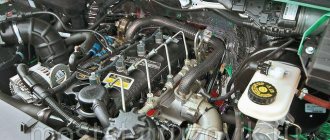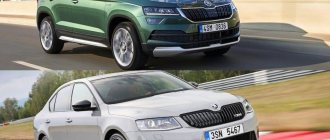In 2013, the Mazda 6 GJ family won a well-deserved victory in one of the categories at a design competition in Essen. The car turned out to be bright and memorable. Even after eight years, it still attracts the attention of its neighbors downstream. The latest technologies at that time were used in the creation of the Mazda GJ. According to the developers, the SkyActiv concept made it possible to achieve the maximum level of safety, efficiency and driving performance. All this is seasoned with aesthetic design and high environmental performance.
Appearance Mazda 6 3rd generation
Mazda 6 GJ before restyling in 2015.
The company's design philosophy is expressed in the short word “KODO”. Loosely translated into Russian, it sounds like “spirit of movement.” At the first glance at the photo, you can be sure that the appearance of the Mazda 6 GJ exactly matches this phrase. The sedan is associated with a racing coupe, which was crossed with a business class car.
The radiator grille is edged with chrome
The front design of the Mazda 6 3 looks aggressive and expensive. The large trapezoidal radiator grille is edged with chrome. Chrome strips radiate from it in both directions, supporting squinted, angry optics. The long hood and muscular front fenders, in the arches of which house wheels on 17-inch wheels (19-inch wheels are available as an option for the Mazda 6 GJ), add to the effect.
Mazda 6 GJ wheels on 17-inch rims (left) and 19-inch rims (right)
The sloping roof falls elegantly and smoothly to the short stern. Embossed trunk lid with stamped spoiler. Stylish LED lights are connected by a chrome strip. Two exhaust pipes peek out from under the bumper on both sides.
Mazda 6 GJ sedan rear view.
The Mazda 6 station wagon looks just as impressive. There are no hints of utility. The exterior, as in the case of the sedan, is shrouded in the spirit of rapid movement.
Mazda 6 GJ station wagon
Mazda 6 - 3rd generation produced from 2012 to the present
Mazda 6 3rd generation was put on display in 2012 at an exhibition in Moscow. Since the same period, production of the third generation Mazda 6 has been launched at a new assembly plant in Vladivostok, only in the sedan body.
The Japanese design school's updated slogan is now "movement in metal" or KODO. The expressive lines of the new body convey the strength and grace of a cheetah ready to leap. In addition to increased strength and lightness, the new Mazda 6 body has excellent aerodynamic performance.
Mazda specialists, thanks to the latest Skyactiv concept, have managed to create a car with an impeccable combination of fuel efficiency and dynamic qualities. The Skyactiv 2.0 (150 hp) and 2.5 (192 hp) engines are powerful and high-speed. They offer the highest compression ratios, lowest fuel consumption and emissions without compromising dynamic performance. Powertrains and the Skyactiv platform have proven that the Mazda 6 not only handles like a sports car, but also has the comfort levels of a top-of-the-line sedan. Now the car interior has become more solid, high-quality and presentable. The suspension has been redesigned - the front multi-link has been replaced with the classic MacPherson strut. The rear is an improved multi-link design.
Mazda 6 2014 demonstrated the first update of the current generation model. The exterior of the restyled version is distinguished by front and rear optics, LED fog lights and a radiator grille. The Mazda 6 interior is equipped with a parking brake button instead of a lever, a modified climate control unit and the location of the multimedia system screen.
Mazda 6 2021 receives the next restyling. The cars are equipped with two petrol engines: a 2.0 liter Skyactiv-G with 150 hp. and 210 Nm and 2.5 l 192 hp. and 256 Nm. Mazda 6 2021 configurations are exclusively equipped with an automatic transmission. All engine modifications meet strict Euro-5 environmental standards and are characterized by minimal consumption. A sedan with a 150-horsepower engine consumes 6.1 l/100 km in mixed mode, and a more powerful modification consumes 0.4 l more.
The main option of the version with the SkyActiv-G 2.5 unit is the latest i-ELOOP braking energy recovery system. The conversion of kinetic energy into electrical energy occurs as soon as the driver releases the gas pedal. Then the accumulated charge is used to power consumers, for example, a media system or climate control. Fuel consumption of Mazda 6 versions equipped with the proprietary i-stop system and the i-ELOOP recovery system is even lower than in the technical specifications.
The car is equipped with a new G-Vectoring Control system, which controls traction and loads the front wheels when cornering.
The 2021 Mazda 6 is unveiled at the Geneva Motor Show. Exterior changes include a new grille, bumpers, chrome trim, and taillights.
The body itself has undergone more significant changes. It has acquired additional stiffening ribs, and sound insulation has been improved by increasing the metal on the floor and rear arches.
The steering received new settings, the chassis was rebuilt: the steering knuckles were modernized and larger shock absorbers were installed at the front, the lever mounts were strengthened and new compression buffers were added at the rear. As a result, Mazda 6 retained its driver's character, but approached neutral understeer.
Noticeable changes in the interior: a new instrument panel with digital instruments, an eight-inch media system display, a climate control unit, ventilated front seats and all-round cameras.
The Skyactiv-G engines have also been upgraded. The two-liter engine has new pistons with asymmetrical rings, a different intake system and increased injection pressure. The 2.5 liter engine now has 194 hp, a lightweight block and a system for shutting off the two outer cylinders at low loads at speeds of 40-80 km/h. In addition, both engines now have active radiator shutters, which open only when necessary, and when closed reduce aerodynamic drag.
Salon Mazda 6 GJ
The interior of the Mazda 6 GJ vaguely resembles the classic design of cars from the Bavarian manufacturer. The interior space is imbued with elegant minimalism with a touch of sportiness. The finishing materials and build quality are excellent, and the ergonomics are thought out to the smallest detail.
Mazda 6 GJ steering wheel with control keys and an 8-inch multimedia system screen.
The dashboard is outlined in straight lines, with an 8-inch multimedia system screen rising above it. The climate control unit is convenient and extremely clear. The driver and front passenger are separated by an impressive tunnel.
In simple trim levels of the Mazda 6 GJ, the tidy is a dial device, in more expensive ones it is digital with a 7-inch screen.
In simple configurations of the Mazda 6 GJ, the tidy is arrow-type. In the center there is a large round speedometer, on the sides there are two more, slightly smaller in size with secondary scales. In expensive trim levels, the analogue tidy is replaced by a digital one with a 7-inch screen. The Mazda 6 GJ steering wheel is embossed with control keys on the spokes. The front seats are comfortable, moderately elastic, have developed lateral support and a wide range of adjustments.
Rear sofa Mazda 6 GJ
Despite the fact that the rear of the Mazda 6 GJ looks compact, three adult passengers can easily sit on the rear sofa. But the transmission tunnel runs through the middle rider’s legs, so he won’t feel too at ease on a long trip. Second-row amenities include a center armrest, air vents, and heated seats.
Trunk
Trunk Mazda 6 3rd generation.
Taking a look at the back of the sedan, you can decide that the luggage compartment is not very spacious. But first impressions are deceiving. The trunk volume of the Mazda 6 3rd generation is average for this class 438 liters. It could be larger, but the wide hinges of the lid eat up some of the space. Hidden underground is a spare tire, a jack and a minimal set of tools. The back of the Mazda 6 GJ rear sofa can be fully reclined to transport long cargo.
The underground contains a spare tire, a jack and a set of tools.
Technical characteristics of Mazda 6 3rd generation
The basis for the Mazda 6 GJ 2013 is the SkyActiv platform. The engine is mounted transversely, torque is transmitted from it to the front wheels. The load-bearing body resists torsional forces in high-speed turns and during diagonal hanging due to the use of high-strength alloy steel load-bearing elements in its design.
Dimensions and volumes
Dimensions of the Mazda 6 GJ
The Mazda 6 2014 belongs to the D-class, but its dimensions go beyond its limits. Length, width and height are 4870x1840x1450 mm, respectively, wheelbase is 2830 mm. The ground clearance of the Mazda GJ is higher than that of some competitors - 165 mm. The vehicle weighs 1370 kg.
Luggage compartment capacity – 438 liters. Gas tank volume – 62 l.
Characteristics of Mazda 6 GJ engines
For Russian buyers, the “six” is available with one of two gasoline engines, combined with a 6-speed automatic or manual transmission.
Engine 2.0 PE-VPS
Characteristics of the Mazda 6 GJ with a 2.0 PE-VPS engine and 6 automatic transmission:
- power – 150 hp;
- torque – 210 Nm;
- compression ratio – 14;
- acceleration to 100 – 10.6 s;
- maximum speed – 207 km/h;
- gasoline consumption in the city, on the highway and average - 8.3; 4.9 and 6.1 l.
Engine 2.5 PY-VPS
Parameters of the Mazda 6 2014 with a 2.5 PY-VPS engine and 6 automatic transmissions:
- power – 192 hp;
- torque – 256 Nm;
- compression ratio – 13;
- acceleration to 100 – 7.8 s;
- maximum speed – 223 km/h;
- fuel consumption in the city, on the highway and average - 8.7; 5.2 and 6.5 liters per 100 km.
Suspension, brakes and wheels
Compared to the previous generation, the wheelbase of the Mazda6 GJ has increased. Moreover, in a sedan it is larger than in a station wagon - 2830 versus 2750 mm. This added legroom for rear passengers, but increased the turning radius.
Independent front and multi-link rear suspension Mazda 6 GJ
The chassis of the Mazda 6 3 consists of an independent McPherson suspension at the front and a multi-link at the rear. All brakes are disc, the front ones are ventilated. Ground clearance 165 mm - an acceptable figure for operation in Russian conditions. Electric power steering. When driving slowly, it turns with one finger, and at speed it fills with a pleasant heaviness, increasing the information content. In stock, Mazda 6 2015 wheels have a size of 225/55R17; by paying extra you can get 225/45R19 rollers.
Safety
Results of the EURONCAP crash test
A crash test carried out using the Euro NCAP method ranked the Mazda 6 3rd generation on the list of the safest models. Already in the database there is a full set of airbags: front, side, curtains. The driver is assisted by electronic assistants: anti-lock wheels, brake force distribution, emergency braking, traction control and directional stability systems. In rich versions of the Mazda 6 2013 there are assistants that help when changing lanes, keep you in the lane and switch the headlights from high to low.
SkyActiv G
SkyActiv G is a family of Mazda gasoline engines that replaced the Z and L-series units. They have been installed on production cars since 2012. In Russia, Mazda 3, 6, CX-5, as well as the new large crossover CX-9 can boast of these new products. In total, the family includes four modifications, differing in volume.
One of the main directions for increasing the efficiency of the line’s engines was increasing the compression ratio. This indicator is key for internal combustion engines. Efficiency, power, torque, fuel efficiency depend on it - everything that motorists have been fighting for throughout the entire existence of this type of power units. The compression ratio is the ratio of the volume of the combustion chamber when the piston is positioned at the lower extreme point to the volume of the chamber when it is positioned at the top point. Compression also depends on it - the maximum pressure of the working mixture in the cylinder before ignition; the higher it is, the greater the force that pushes the piston down after ignition, the greater the power output.
In Skyactive engines, it was possible to increase the compression ratio to 14:1. For comparison, in the previous MZR 2.0 engine, which was installed on Mazda 3 and 6, this figure was 10:1. In Kia/Hyundai engines with direct injection 1.6 - 11, and around this figure it is found in all modern gasoline passenger cars. So why isn’t it increased, since it gives a significant increase in productivity? The fact is that in this case the possibility of detonation increases, and, usually, to avoid it, gasoline with a higher octane number is used. But in the case of serial Mazda engines, it is clear that this solution is not suitable; the cars must normally digest regular 95-octane gasoline, and besides, it is not of the highest quality in all regions where the cars are supplied.
To combat detonation, the Skyactiv engine is equipped with ion sensors that determine the likelihood of detonation from the ion trace after the spark plug fires, applying voltage to its electrodes and measuring the current between them. The fuel injection pump is used according to the diesel principle, which creates a pressure in the chamber higher than that of turbocharged engines. For better fuel atomization in the cylinder, new high-efficiency six-hole injectors are used.
The pistons are of particular interest - in addition to the valve bores, they have a recess in the center and a convex bottom shape, which contribute to a more uniform concentration of the working mixture around the spark plug when a spark occurs and further spread of ignition throughout the combustion chamber, and also make the combustion process longer .
The phase change system is represented by two couplings on both shafts. At the outlet it is hydraulic, at the intake it is driven by an electric motor. They allow you to effectively control torque over a wide speed range.
The mass of the motor was significantly reduced - by 10% and friction losses - by 30%. According to Mazda, torque increased by 15%, fuel consumption and CO2 emissions decreased.
To increase the efficiency of the exhaust system, we used the 4-2-1 spider, familiar to tuning enthusiasts, which, due to its structure, reduces the resistance to the removal of exhaust gases and reduces the back pressure that strangles the engine.
As we can see, the Skyactiv engine is, in fact, a tuned version of the usual Mazda aspirated engine, deeply modified to unlock reserves that made it possible to increase its performance.
Gasoline engines of this technology have four displacement options:
- 1.3 - a typical representative of the “downsizing” concept, installed on Mazda 2, not sold in Russia;
- 1.5 (P5-VPS) is used on Mazda 2, 3, the MX roadster so popular in the USA;
- Skyactiv 2.0 (PE-VPS) - motor for a wide range of models - 2, 3, 6-series, MX-5, CX-3, CX-5;
- 2.5 (PY-VPS) - in its turbocharged version, it is installed on the CX-9 crossovers that have recently gone on sale. There are also “threes”, “sixes”, CX-5 with this engine.
Return to contents
Restyling Mazda 6 2015
Mazda 6 GJ after restyling in 2015.
An updated version of the 3rd generation Mazda6 went on sale in 2015. The appearance of the sedan has not changed much. The designers slightly straightened the radiator grille, bumpers and headlights and added new wheel rims. But the salon has changed dramatically. The front panel and center console were completely redesigned. We installed another multimedia system. The driver and front passenger got new seats. Also, the restyling of the Mazda 6 GJ boasts improved sound insulation.
Technical changes
The characteristics of the Mazda 6 GJ engines have not changed during the 2015 restyling, but there are plenty of changes in the technical part. The first thing that catches your eye is that the mechanical parking brake lever has disappeared, replaced by an electric handbrake. The design of the chassis as a whole remained the same, only new lower arms at the front and different shock absorber struts were installed.
Mechanical handbrake before restyling (left) and electric handbrake after 2015 (right)
To achieve greater efficiency from the 2.5-liter Mazda 6 3 engine, engineers installed the i-ELOOP system on it. It recovers energy during braking, stores it if necessary and provides power to the electrical system. The idea turned out to be successful - the older engine consumes fuel on average only half a liter more than the 2-liter, and the difference between them in acceleration to hundreds is almost 2 seconds.
i-ELOOP system
Even the basic equipment of the Mazda 6 2021 is stuffed with modern safety systems. For example, GVC technology monitors road conditions (rain, snow or ice) and, based on them, adjusts the torque of the Mazda 6 GJ. The system effectively increases the grip of the wheels on the road surface, both in turns and on a straight line. The i-Activesense electronic package is available as an option. It consists of an expanded set of electronic assistants. These include systems such as lane marking monitoring, blind spot monitoring, emergency braking, etc.
Mazda 3 e-SkyActiv X 2021: review of the new Japanese hybrid
Subtle improvements to the Mazda 3's powertrain have come with the new e-SkyActiv X unit. The engine still has some inherent shortcomings, but at least Mazda has made the most of the package with its technological tricks. The Mazda 3 hatch still rides and handles as well as ever, and the interior is one of the most premium in its class. It's just a pity that it's not particularly practical.
Mazda is a strong example of a company that is constantly improving its vehicles, and the latest round of updates is centered on the Mazda 3 family hatchback.
The first car was launched in 2021, featuring a super-sharp design and a smart technology-packed Mazda SkyActiv X engine that uses a compression-controlled spark ignition process. This technology basically combines some of the characteristics of a diesel engine to create extra torque with the cleanliness and agility of a petrol unit.
The powertrain now features mild hybrid technology and even more upgrades, with the engine dubbed "e-SkyActiv X" to clearly reflect all these changes. The hybrid produces an additional 6 liters. With. and 16 Nm of torque, up to corresponding outputs of 183 hp. With. and 240 Nm from a 2.0-liter naturally aspirated four-cylinder engine. Power output is influenced in part by revised intake valve timing, which also improves efficiency.
Mazda's mild hybrid system has been recalibrated with new software to help improve response and smoothness under acceleration, as well as reducing CO2 emissions by 5-11g/km depending on specification.
According to Mazda, acceleration is smooth throughout the rev range, even if the 2.0-liter unit is a little louder than a modern downsized turbo engine. It needs to rev too because its maximum torque is produced at 4,000 rpm, so despite a little electrical assistance (which you won't notice), it's still a hard-working unit and that means the engine has all those same shortcomings.
However, you can appreciate the excellent six-speed manual gearbox, which shifts easily and precisely, making it a real pleasure to use. It's actually not even a problem in traffic because the clutch is light.
The Mazda 3's steering also has plenty of weight to it, and there's enough feedback to call it truly engaging. Mazda's steering is very good and this is linked to a chassis that offers a high degree of comfort, plenty of grip and a fun-to-drive feel. Few family hatches combine such a strong sense of balance with such levels of comfort.
The Mazda 3 is a good performer in many ways, but the engine isn't quite up to par with the best in class and the car is a bit cramped inside. This isn't helped by the 3's flamboyant exterior design: inside the back row feels claustrophobic due to the chunky stance, even if legroom is fine - but that's about it.
The boot capacity is 334 liters, but even the Volkswagen Golf offers around 15% more boot space. From the front everything looks much more impressive. The interior design was as important as its appearance, with high quality and a much improved infotainment system.
Both elements have stood the test of time: interior quality feels as high as it did a few years ago, and compared to the latest Golf, which now contains harder grades of plastic, the Mazda 3 is a more premium proposition.
The 8.8-inch infotainment screen takes center stage and is controlled by an intuitive wheel. The system is fine, but Android Auto and Apple CarPlay are available and it's better to use them.
The GT Sport version costs from 2.8 million rubles, and has heated leather seats and a heated steering wheel, universal parking sensors with a rear view camera, 12-speaker Bose stereo, adaptive LED lights, dual-zone climate control, keyless mode, 18- inch alloy wheels and plenty of safety technology. These include autonomous braking, lane keep assist, blind spot monitoring with cross-traffic alert and lane departure warning.
| Model: | Mazda 3 2.0 e-SkyActiv X GT Sport |
| Price: | 2.8 million rubles |
| Engine: | 2.0 liter 4-cylinder petrol MHEV |
| Power/torque: | 183 hp/240 Nm |
| Transmission: | Six-speed manual, front-wheel drive |
| Acceleration 0-100 km/h: | 8.1 seconds |
| Maximum speed: | 215 km/h |
| Fuel consumption: | 4.41 l/100 km |
| CO2: | 121 g/km |
| On sale: | Now |
Similar
Test drive Mazda 6 GJ
The choice of power units for the 3rd generation Mazda 6 is not large. There are only two of them: gasoline volumes of 2 and 2.5 liters. There is also a diesel engine on the European market, and cars with it can be equipped with all-wheel drive. But such copies are not supplied to us. The 2-liter engine is not conducive to aggressive driving. Its capabilities are sufficient, but just limited. Still, the almost five-meter sedan is too heavy for him. The engine cannot be called completely “vegetable”; on the highway you can easily overtake, but you will have to press the trigger to the floor. But the 2.5-liter unit gives a completely different feeling. It instills confidence that the traction reserve will be sufficient in all cases. It is paired with a 6-position automatic machine. Only the younger engine has a manual transmission on the Mazda 6 2017.
The brakes confidently settle the car. Their effort is unmistakably controlled by the pedal. The electric power steering regularly measures the force and gives the driver feedback to the wheels, helping to accurately adjust the trajectory of the Mazda 6 GJ at speed.
By creating the Mazda 6, the Japanese once again shook up the chassis. They managed to achieve maximum balance. The suspension does not bother you with rolls when cornering, while the ride quality is excellent. It absorbs small bumps unnoticed by passengers, and only modest shocks are felt from medium ones. The sound insulation in the Mazda 6 2016 after restyling is well designed. The engine and street sounds are practically inaudible, but on the highway the noise from the wheels penetrates into the cabin through the arches.
Cons of the “Six” 3rd generation
Mazda 6 3 has a whole army of fans for a reason. This is a balanced and thoughtful car. But the stumbling block is that the car is attractive to both respectable older men and young people. And it’s not easy to please such a diverse target audience. Everyone can find something inconvenient for them in a sedan. But we will not dwell on such trifles, but consider the main disadvantages:
- Weak paintwork. The Mazda 6 GJ is not cheap, and this makes it doubly offensive when scratches appear on the body from light contact with branches or thorns. There is a risk of damaging the paintwork even during washing by wiping the car with a rag.
- Poor sound insulation of the Mazda 6 GJ before the update. The engine is well isolated from the passenger compartment and is practically inaudible. The impression is spoiled by the wheel arches. Through them, noise easily penetrates into the car.
- Fogging of the front optics and rear lights. Basically, this problem is inherent in pre-restyling Mazda 6. At one time, the manufacturer recognized the flaw and replaced the optics under warranty with... exactly the same ones, which, naturally, after some time again became covered from the inside with drops of condensate.
- Wear resistance of Mazda 6 GJ interior. The steering wheel and selector knob quickly begin to peel off, and the plastic is easily scratched. Textile upholstery of seats, if not covered with covers, soon takes on an unpresentable appearance.
- Creaky suspension. It's all about low-quality anthers and seals. Sometimes they broke even on short runs. As a result, dirt got into the nodes, which led to squeaks and breakdowns. On later Mazda 6s this problem has been solved.
- Glitches of the multimedia system on pre-restyling Mazda 6 GJ. Most often, the rear view camera and radio may fail.
Reviews
Let's divide the reviews of real drivers into two points, depending on which engine was installed.
2.0
Review of Mazda 6 GJ
Click to enlarge
Real reviews about Mazda 6 GJ
Click to enlarge review
2.5
We took drivers' opinions (reviews) about the Mazda 6 GJ from the website drom.ru
Leave your reviews and opinions about the Mazda 6 GJ in the comments. Thank you.
Mazda 6 3rd generation is capable of captivating with its design and driving characteristics. It must be admitted that the early copies were crude in terms of quality. However, the manufacturer eliminated many of the shortcomings after the first restyling. Sales of the Mazda 6 GJ in Russia were hit hard by the devaluation of the ruble in 2014. But originality and charisma do their job - the car has risen in price without losing its fans.
Engine tuning Mazda 3/6/CX-5 Skyactive 2.0 l.
Chip tuning SkyActiv 2.0
Everyone knows that the European SkyActiv 2.0 engine produces 165 hp, in some countries the power is reduced to 150 hp, but judging by the measurements, the power is reduced only on paper. Therefore, you need to remove the catalyst, do chip tuning and get 170 hp. without reducing resource. It will not be possible to install a turbine on SkyActive, due to the very high coolant and the need to replace the piston with a forged one, followed by converting the engine from SkyActive to a regular 2 liter. Any methods of supercharging on SkyActive will lead to serious consequences for the engine.
ENGINE RATING: 4+
<<BACK











